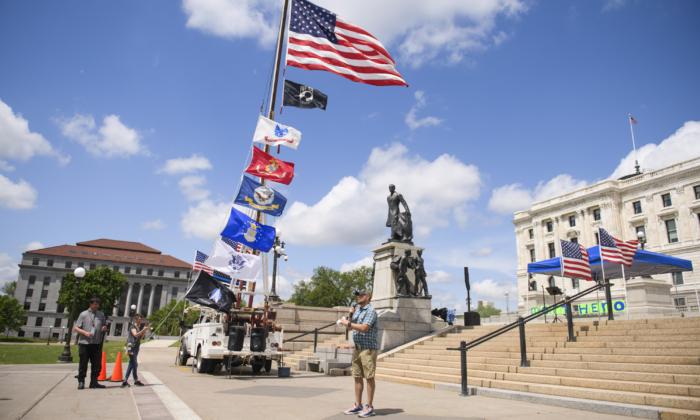There are 435 U.S. House and 34 U.S. Senate seats on midterm referendums nationwide, with voters also set to elect 36 governors. But these contests will only be seen by people in most states when they go to the polls on Nov. 8.
Amid the sustained shrinkage of local and state media outlets and mushrooming growth of 24/7 cable news networks and digital news sites that nearly exclusively focus on national issues and midterm races, state legislatures garner increasingly less coverage beyond undermanned capitol news bureaus that are often mere shells of their former staffing.
But make no mistake: State lawmakers adopt policies, impose regulations, and issue decisions that have more relevancy and impact in voters’ day-to-day lives than those that come from Congress.

Impact on Daily Life
Outside of national defense, foreign policy, immigration, and interstate commerce, state legislatures are responsible for nearly everything else that the government deals with.State lawmakers are the primary decision-makers across an array of concerns, including education, health care, infrastructure, elections, land use, sales taxes, firearms, and utilities, while controlling more than $2 trillion in yearly balanced-budget spending. After June’s U.S. Supreme Court repeal of Roe vs. Wade, that realm of responsibilities now includes regulating abortion access.
As U.S. Supreme Court Justice Louis Brandeis said in 1932, state legislatures are the “laboratories of democracy.” On legislatures’ dockets in 2023 will be the annual top three issues—state budgets, education, and health care—as well as legislation related to marijuana, autonomous vehicles, energy, prescription drugs, data privacy, policing, sports gaming, liquor laws, tax policies, family paid leave, technology, and school choice.
State legislatures can greatly vary in size and scope—unicameral Nebraska only has a 49-member nonpartisan Senate, while New Hampshire has 400 representatives in its House alone.
Lawmakers in four states—Texas, Montana, North Dakota, and Nevada—don’t convene in even-numbered years, while those in eight states—California, Illinois, New Jersey, New York, Pennsylvania, Michigan, Illinois, and Ohio—meet year-round with recesses. Most state legislatures are in session for 30-to-90 days per year.
Yet state lawmakers are far more prolific than their congressional counterparts during their breakneck annual legislative sessions. An analysis by Quorum States, a Washington legislation-tracking service, has documented that state legislatures introduce 23 times more pieces of legislation than Congress does annually. The average state lawmaker either sponsors or signs onto 33 measures, with about four being adopted each session.
According to Virginia-based MultiState, a state and local government relations and analytics firm, state lawmakers, on average, collectively introduce nearly 250,000 pieces of legislation per year, adopting about 30,000 annually.

Republicans Dominate
Going into the Nov. 8 elections, of 98 state legislature chambers—Nebraska being the 99th unicameral, nonpartisan body, but certainly Republican in all but name—61 have Republican majorities and 37 are controlled by Democrats.Collectively, there are 3,978 Republican state lawmakers constituting 52 percent of the state legislature seats nationwide. Democrats control 47 percent percent of the seats.
Republicans control both chambers in 30 states, and Democrats own both senate and house majorities in 17 states. There are 23 states with Republican trifectas, meaning that the governor is also from the same party. Democrats have 15 trifectas.
Only three state legislatures are split, with different parties controlling either of the two chambers, and only 12 states don’t have unified party control of the senate, house, and governor’s mansion, the second-lowest ratio in 70 years, “a sign that ticket-splitting may be waning nationwide” among voters, according to the National Conference of State Legislatures (NCSL).
The senates in Alaska and Minnesota are held by the Republican Party, while the states’ lower chambers are controlled by Democrats. It’s just the opposite in Virginia, which along with Louisiana, Mississippi, and New Jersey, won’t have state legislature elections on their Nov. 8 ballots.
Republicans have been ascending in state legislatures for the past 20 years. Democrats haven’t held a majority of seats nationwide since 2010, when the Republican Party captured majorities in 24 chambers. Democrats have rebounded slightly since 2016, when Republicans won majorities in a peak 66 chambers.
The Nov. 8 general election will be the first round of state legislative races in the wake of post-2020 Census redistricting.
“Watch for more races between incumbents and contested races where the political geography has changed significantly—particularly in suburban areas,” the NCSL stated in its 2022 election preview. “More turnover is a possibility.”
Also, while there are “several hundred new freshman legislators” elected nationwide in every election, these numbers tend to be higher in the first election after decennial redistricting, the NCSL noted.
“This year, we expect the number to be closer to 1,000, or just under 15 percent of the nationwide total,” the organization stated.
The NCSL rates state legislature races in 21 states to be competitive enough that control of chambers could change hands. Over the past century, an average of 12 chambers change party control in each general election cycle, but the organization noted that “that number has declined in recent years.”
That stay-put trend will likely unfold in the midterms. “While individual races may yield some upsets, chamber control is unlikely to change” in many—if any—chambers, according to the NCSL.
“Chambers held by Democrats appear to be more competitive than those held by Republicans,“ the organization stated. ”That means Republicans have more opportunities to make gains.”

Most Competitive Statehouse Elections
According to NCSL, partisan control of 12 state senate chambers, including five now held by Republicans, and nine state houses, including five held by Democrats, are up for grabs on Nov. 8.Ballotpedia has identified 28 battleground chambers in 19 states, including 16 senates and 12 houses.
A projection by CNalysis, a state legislature analytic site, forecasts that the Republicans will gain up to 147 state legislative seats nationwide, including 41 to 42 in senates and 102 to 103 in the houses. Here are outlines of projections in key state legislature elections:
Ballotpedia has identified seven battleground Arizona Senate races, including three in Democratic-held districts and four in Republican-held districts, and seven battleground House races, including three in Republican-held districts, two in Democratic-held districts, and two in split districts.
CNalysis offers no projection for Arizona Senate races and forecasts that Republicans could gain a House seat.
Ballotpedia has tabbed 10 Senate contests as battleground races, including four in Democratic-held districts and six in Republican-held districts. It rates 28 House elections as battleground races with 16 in Democratic-held districts and 12 in districts occupied by Republican incumbents.
CNalysis projects that Democrats will pick up two to three Senate seats and up to two House seats, narrowly missing flipping both chambers.
Ballotpedia rates 27 Senate elections as battleground races, including 13 in Democratic-held districts, 13 in Republican-held districts, and one in an independent-held district. There are 42 Ballotpedia battleground House races, including 21 Democratic-held and 21 Republican-held districts.
CNalysis forecasts no change in the Senate but projects that Republicans could gain four to five House seats, potentially flipping the chamber.
Ballotpedia has identified nine Senate battleground races, including four in Democratic-held districts, four in Republican-held districts, and one held by an independent. In the House, there are 34 Ballotpedia battleground races, including 11 held by Democrats and 23 by Republicans.
CNalysis projects Republicans could gain a Senate seat, while Democrats could chip into the Republicans’ House majority by adding up to five seats.
The NCSL and Ballotpedia identify the Senate as a potential flip with eight Senate seats defined as battleground races, including five held by Democrats and three held by Republicans.
CNalysis projects no significant changes, with Republicans potentially gaining a Senate seat.
The NCSL and Ballotpedia have identified the Senate as competitive with five battleground races in three Democratic-held districts and two Republican-held districts.
CNalysis projects that Republicans could gain up to two Senate seats.
CNalysis projects that Republicans could gain up to two Senate seats and up to four House seats, potentially gaining control of the chamber.
The NCSL and Ballotpedia rate both chamber elections as competitive. Ballotpedia classifies four Senate elections as battleground races, including two each in Democratic-held and Republican-held districts. There are 16 Ballotpedia battleground House races, including 10 in Democratic-held districts and six in Republican-held districts.
CNalysis projects that Republicans could gain a Senate seat and up to three House seats, with the Senate potentially flipping.
The NCSL and Ballotpedia have identified both chambers as competitive. Ballotpedia rates 20 Senate elections as battleground races, including 14 in Democratic-held districts, and 53 House elections as battleground races, including 32 in Democratic-held districts.
CNalysis projects that Republicans could gain up to four Senate seats, coming close to flipping the chamber, and up to four House seats.





